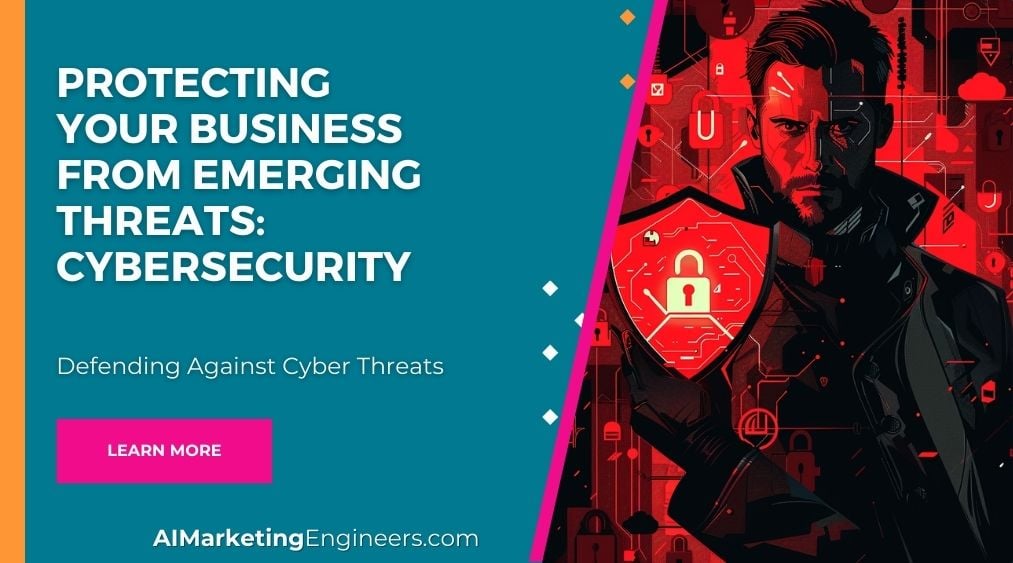Key Takeaways
✅ Implement Proactive Measures: In today's digital age, cybersecurity isn't just an option; it's a necessity. With cyber-attacks increasing by 300% over the last year according to the FBI's Internet Crime Report, businesses are more vulnerable than ever. Implementing firewalls, conducting regular employee training, and encrypting sensitive data can reduce the risk of data breaches significantly. Adopting these proactive measures ensures your business remains resilient against cyber threats.
✅ Stay Up-to-Date with Security Updates and Best Practices: As cybercriminals evolve, so should our defenses. A shocking 60% of breaches in the past year could have been prevented with routine updates, per cybersecurity firm, Check Point. Leveraging the latest in cybersecurity technology, like Next-Generation Firewalls and multi-factor authentication, plays a critical role in safeguarding against unauthorized access. It’s crucial for businesses to not only update regularly but also to stay informed on the latest cybersecurity trends.
✅ Foster a Culture of Cybersecurity: Building a culture that prioritizes cybersecurity can dramatically reduce the risk of insider threats, which account for 34% of all cyber-attacks, according to Verizon’s Data Breach Investigations Report. Limiting data access, conducting thorough security audits, and ensuring every new hire understands your cybersecurity policies are steps in this direction. Remember, a well-informed team is your first line of defense.
 Introduction
Introduction
Could your business survive a cyber-attack? With cybersecurity threats evolving at an accelerating pace, the importance of protecting your business from emerging threats cannot be overstated. Cybersecurity is not just about protecting your systems; it's about safeguarding your business's future. Every day, small businesses are targeted because they are seen as less guarded and easier to breach. From phishing scams to ransomware attacks, the threat landscape is vast and continuously changing.
This article delves into the significance of keeping your business secure in the digital age, offering innovative perspectives, modern trends, and practical solutions. Whether it’s about staying ahead of emerging threats or fostering a culture of cybersecurity, we'll equip you with actionable insights and the latest strategies to not only protect your business but also to secure its growth in the digital frontier. Get ready to uncover groundbreaking information that will not only enlighten but also empower you and your business in the battle against cyber threats.
Top Statistics
| Statistic | Insight |
|---|---|
| 46% of all cyber breaches impact businesses with fewer than 1,000 employees | This statistic is a clear indicator that small businesses are prime targets, underscoring the vital importance of cybersecurity measures regardless of company size. |
| 61% of SMBs were the target of a cyberattack in 2021 | The majority of small and medium-sized businesses have faced cyber threats, highlighting an urgent need for proactive defense strategies. |
| 82% of ransomware attacks in 2021 were against companies with fewer than 1,000 employees | Ransomware attackers frequently target smaller businesses, possibly due to lower defense capabilities and the perception of easier targets, making it critical to invest in robust cybersecurity defenses. |
| 47% of businesses with fewer than 50 employees have no cybersecurity budget | Nearly half of very small businesses are vulnerable to attacks due to lack of investment in cybersecurity, demonstrating a significant gap in preparedness. |
| 87% of small businesses have customer data that could be compromised in an attack | The vast majority of small businesses handle sensitive customer information, which could have devastating consequences if exposed, making cybersecurity a crucial part of customer trust and business integrity. |
Understanding the Threat Landscape
In an era where digital technology underpins almost every aspect of business operations, the cybersecurity threat landscape is evolving with alarming sophistication. Today's businesses, especially small businesses, find themselves grappling with an array of cyber threats, from social engineering fraud to malware and ransomware attacks. The statistics are eye-opening: a significant percentage of small businesses have experienced some form of a cyberattack. Limited resources and a perceived lack of cybersecurity knowledge make these businesses particularly vulnerable. But what is the real impact of these attacks? Beyond immediate financial losses, they can damage a business's reputation and customer trust, which are often far more challenging to rebuild.
Educating Employees and Implementing Safe Practices
One of the most effective defenses against cyber threats is employee education. Employees should be trained to recognize phishing emails, which are deceptively crafted to look legitimate to trick individuals into providing sensitive information. Regular training on safe internet usage and the importance of strong passwords can significantly reduce a business's vulnerability. Implementing robust password policies and keeping software updated are also crucial steps in protecting against breaches. Did you know that a significant portion of cyber incidents could be prevented by maintaining updated software and educating employees on cyber hygiene practices?
Assessing Business Risk and Creating a Cybersecurity Plan
Understanding and mitigating risks is at the heart of good cybersecurity. Conducting a cybersecurity risk assessment can reveal the specific vulnerabilities a business faces. Tools like the Small Biz Cyber Planner 2.0 offer tailor-made advice for small businesses looking to shore up their defenses. Creating a comprehensive cybersecurity plan is not just about technology; it's about culture and habit. It means training users, securing email platforms, and systematically protecting information systems to mitigate risks effectively.
Securing Networks and Data
To safeguard against threats, businesses must implement strong network security measures. This includes deploying firewalls, intrusion detection systems, and anti-malware software. Furthermore, data encryption plays a critical role in protecting sensitive information from unauthorized access. Periodic data backups ensure that, in the event of data loss, companies can quickly recover without paying a ransom or losing critical operational capabilities. Are businesses doing enough to secure their networks and data from cyber threats? The increasing frequency of cyber incidents suggests a gap in effective security practices.
Managing Third-Party Risks and Incident Response
The cybersecurity posture of third-party vendors can significantly impact a business's security. Establishing security requirements for third-party partners and continuously monitoring their compliance is vital in minimizing risks. Additionally, having a well-defined incident response plan ensures a business can respond swiftly and effectively to a breach, minimizing damage and expediting recovery. Proper planning includes establishing communication protocols and clear guidelines for remediating and recovering from incidents.
Staying Ahead of Emerging Threats
The cyber threat landscape is constantly evolving, necessitating businesses to stay informed about emerging threats and adapt their security measures accordingly. Regular updates and patches can address known vulnerabilities, making it harder for attackers to exploit software flaws. Organizations like the FCC and CISA offer invaluable free resources and tools to help businesses enhance their cybersecurity resilience. Staying informed and proactive is the key to guarding against the sophisticated cyber threats of today and tomorrow.
In conclusion, as the digital landscape continues to evolve, so too does the complexity of cybersecurity challenges. By understanding the threats, educating employees, assessing risks, and implementing robust security measures, businesses can significantly reduce their vulnerability to cyberattacks. This comprehensive approach is essential for safeguarding a company's data, reputation, and future.
AI Marketing Engineers Recommendation
Recommendation 1: Prioritize Employee Training on Cybersecurity Practices: Education is your first line of defense in Protecting Your Business from Emerging Threats: Cybersecurity. Statistics show that human error accounts for up to 95% of cybersecurity breaches. Investing in regular, interactive training sessions for your employees can significantly reduce this risk. These sessions should cover topics like how to identify phishing emails, the importance of strong passwords, and safe web browsing habits. By fostering a culture of cyber-awareness, you can create a human firewall that acts as a significant deterrent against cyber-attacks.
Recommendation 2: Implement Multi-Factor Authentication (MFA) Across All Systems: With cyber-attacks becoming more sophisticated, simple passwords are no longer enough to ensure your business's digital safety. Multi-Factor Authentication adds an extra layer of security by requiring two or more verification factors, making it much harder for unauthorized users to gain access to your systems. According to recent reports, implementing MFA can prevent 99.9% of account compromise attacks. This relatively simple step can dramatically enhance your defense mechanisms in Protecting Your Business from Emerging Threats: Cybersecurity.
Recommendation 3: Utilize AI-Driven Threat Detection and Response Tools: The digital landscape is evolving, and so are the threats. Traditional security measures might not be able to keep up with the sophistication and speed of modern cyber-attacks. AI-driven tools can analyze patterns, detect anomalies, and respond to threats in real-time, offering a proactive approach to Protecting Your Business from Emerging Threats: Cybersecurity. These tools can significantly decrease the time between threat detection and response, reducing potential damage. With cyber-attacks becoming more frequent and severe, investing in AI-driven cybersecurity tools is no longer a luxury but a necessity.
Conclusion
As we've navigated through the complexities of cybersecurity threats, it's clear that protecting your business is more crucial than ever. With threats growing not only in sophistication but in frequency, every business, especially small businesses, must rise to the challenge. Remember, it's not just about having the most advanced technology; it's about understanding the threat landscape, fostering a culture of cybersecurity awareness among employees, and implementing robust practices to safeguard your operations.
The journey starts with educating employees—the frontline defenders of your digital domain—on safe internet practices and the importance of strong passwords, alongside the deployment of technical defenses like firewalls and anti-malware solutions. Equally vital is the creation of a comprehensive cybersecurity plan, a blueprint for action that includes regular risk assessments and measures for protecting data, whether it rests in your servers or flows through the digital veins of the internet.
In forging a path forward, it’s about securing not just your internal processes but also managing the external risks presented by third-party vendors. And in the realm of cybersecurity, anticipation is the name of the game. Staying informed and adopting a proactive posture will enable your business to not just respond to threats but to anticipate and mitigate them before they manifest.
Let’s not forget, in the digital age, the resilience of your business is intricately linked to how well you protect yourself against emerging threats. By taking the insights shared here—you're not just defending your business; you're securing its future. Whether it's utilizing free resources from the FCC and CISA, or simply starting the dialogue about cybersecurity within your team, the time to act is now. Armed with knowledge and the right tools, your business can not only survive but thrive in an ever-changing cyber landscape.
FAQs
Question 1: Why is cybersecurity important for businesses?
Answer: Cybersecurity helps protect businesses from data breaches, malware, phishing attacks, ransomware, and other cyber threats. It's crucial for preventing financial losses, safeguarding reputations, and ensuring operations run smoothly while complying with regulations and protecting customer data.
Question 2: What are the biggest cybersecurity threats for SMBs right now?
Answer: SMBs face threats like ransomware, social engineering, and phishing attacks, similar to larger companies. The focus should be on proactive maintenance to prevent unauthorized access.
Question 3: How much should we be spending on information security-related tools and controls?
Answer: Spending varies based on many factors, but on average, around 11% of an IT budget goes to cybersecurity. This includes spending on threat monitoring, security tools for endpoints and networks, and identity access management.
Question 4: Do I have to have a designated information security expert on staff or a third-party advisor?
Answer: It depends on your in-house IT team’s qualifications. Sometimes an external team is necessary for thorough assessments and strategic advice.
Question 5: How much training should we be giving our employees and where should we start?
Answer: Training is essential, focusing on phishing, threat awareness, and incident reporting. This training curbs human error and prepares employees to tackle cybersecurity challenges.
Question 6: What are our critical assets and their vulnerabilities?
Answer: Identifying key assets and vulnerabilities helps in prioritizing protection efforts, staying informed on regulations, and developing incident response plans.
Question 7: How can we evaluate the security measures of third-party vendors and partners?
Answer: Evaluate vendors by enquiring about their security policies, certifications, and software update practices, ensuring they meet your organization's standards.
Question 8: What should our overall goals be for cybersecurity?
Answer: Aim for a comprehensive strategy including continuous monitoring, ongoing improvement, and a detailed incident response plan.
Question 9: How can we implement robust monitoring systems?
Answer: Invest in real-time threat detection tools and regularly update your security measures to protect against new threats.
Question 10: How can we ensure our business is prepared to respond to cybersecurity incidents?
Answer: Develop a disaster recovery plan with detailed incident response strategies and ensure it is regularly updated.
Academic References
- Cybersecurity Readiness Framework for Business Organizations. This study proposes a staged cybersecurity readiness framework for business organizations to mitigate risks during digital transformation, highlighting the importance of comprehensive cybersecurity measures to prevent interruptions and unauthorized access. Further reading can be found in detail within the context of its publication.
- The Impact of Cyber Security on Business. This research emphasizes the need for businesses to take a cautious approach to IT risk management and cybersecurity threats, recommending the development of a new framework to protect systems and prevent cybercriminal activity. The source provides an in-depth exploration of the proposed framework and its implications for businesses.
- Counterattacking Cyber Threats: A Framework for the Future. Outlining the importance of implementing cybersecurity measures, collaborative information sharing, and digitalization capabilities to enhance operational resilience and mitigate cyber threats, this study serves as a guide for future strategies in combating cybersecurity challenges.
- The New Frontier of Cybersecurity: Emerging Threats and Innovations. This comprehensive review article explores emerging cybersecurity threats, emphasizing the need for robust security measures, employee training, and proactive threat intelligence to counter these threats effectively. It serves as a crucial resource for understanding the landscape of cybersecurity and paving the way for innovative solutions.











